Literature
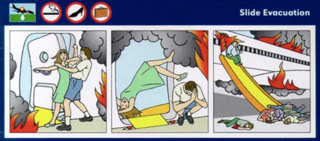
This post is a sneak peek of part of an essay of mine that is being published in a book called Beauty, Violence, Representation (as part of the Routledge Research in Cultural and Media Studies series). My chapter adapts Arun Agrawal?s term "environmentality" to think about how air travel disasters are represented and mediated in contemporary U.S. culture.
Agrawal uses the term environmentality to describe how people become political subjects through the creation and dissemination of environmental policies and ecological knowledge. Agrawal demonstrates how, as land and resources become objects of statistics, ordered consumption, and conservation, environmentality emerges through people becoming certain kinds of subjects: environmental subjects. This is not necessarily a specific way of inhabiting or treating an environment, but rather accounts for how people gradually become implicated in and subject to specific cultural and political designations about what an environment is in the first place.
A couple pages into my essay, I discuss a visual text from the everyday culture of flight that helps illuminate how I employ this critical term. Environmentality in the sense I am using it is apparent on safety briefing cards in commercial airliners, where the inside technologies and outside ecosystems are juxtaposed stark form.
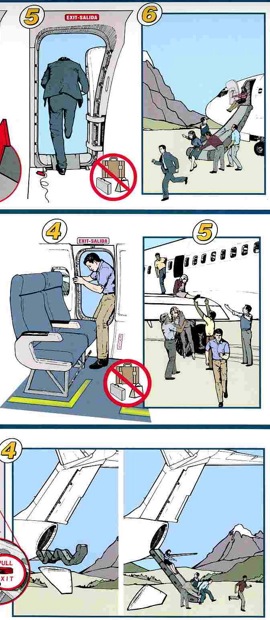
Lingering on this emergency briefing card, we can see how the potentially harrowing event is tied to an environmental-aesthetic register: the sky is intensely blue, and the dramatic snow-peaked mountains give way to verdant forests?it is an encompassing ecosystem rendered in miniature. The beauty and eco-logic of a world beyond thus somehow buttresses the violence of the plane crash. Outside the wrecked airplane and its tight seating configurations, one finds oneself in an ecological tabula rasa, a space open to inhabitation and free mobility.
The shattered dream of the passenger traveling by air ends up on the ground, and the violence of the crash becomes a portal into a pristine, beautiful wilderness. The air travel disaster becomes a zero point for a survivalist fantasy, a reset button that places the human subject back in a pure state of nature, like Robinson Crusoe on his island. In other words, the techno-culture of modern air travel is subtended by a mindset of naturalism, and by an idea of beautiful wilderness as an always-available foundation point where human progress can begin afresh.
--
Here are the rest of the images that the essay refers to:
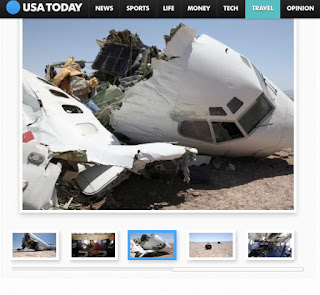
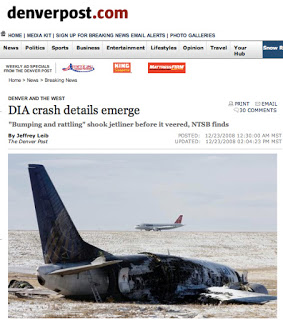
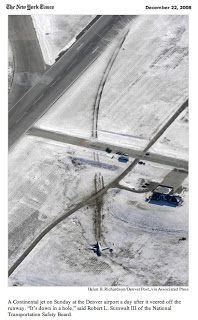
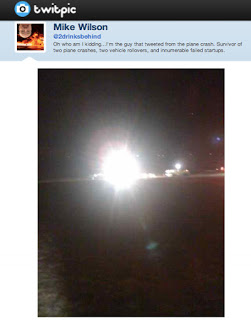
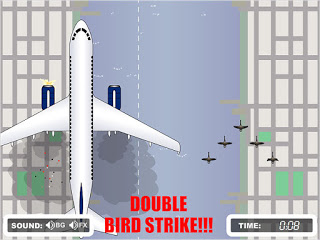
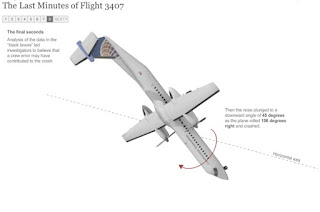

- Two Ways Of Looking At Emergency Slides
This gem just arrived in the mail: An Air France A380 emergency briefing card, and some airport haiku, from my awesome & inspiring architect cousin, Emily White! One haiku reads: Passenger paradeMysterious upper deckWho is sitting there? In other...
- Airport Reading, Airplane Reading: Definitions & Distinctions
Airport reading, airplane reading. What's the difference? These two phrases often are conflated or used interchangeably. I use these phrases in fairly distinct ways, which I want to delineate briefly here. Airport reading can mean just the trashy...
- What Is "airport Reading"?
Dominique Browning has a fascinating piece in the New York Times today called "Learning to Love Airport Lit." The article is a persuasive (and also humorous) take on the most effective kinds of airport reading. In Browning's words, the ideal airport...
- It's In The Air
A short essay about my airport work?cleaning out aircraft seat-back pockets at night?is in the current issue of Narrative magazine. Meanwhile, over at Room 220 Nate Martin recently discussed the fantastic atmospheric photographs of JFK by Sophie Lvoff,...
- On Crashing: An Inquiry Of Fragments
We chose this plane because we didn?t know that It would become the subject Of a poem. To us poetry is ludicrous, As if telling a hawk he has talons. ?Mark Yakich, ?Last Flight out of a State of Mind? A recent article from the Times reports that the...
Literature
Environmentality & the Visual Culture of Plane Crashes
"Project Mayhem" briefing card from the film Fight Club (20th-c Fox, David Fincher, 1999)
This post is a sneak peek of part of an essay of mine that is being published in a book called Beauty, Violence, Representation (as part of the Routledge Research in Cultural and Media Studies series). My chapter adapts Arun Agrawal?s term "environmentality" to think about how air travel disasters are represented and mediated in contemporary U.S. culture.
Agrawal uses the term environmentality to describe how people become political subjects through the creation and dissemination of environmental policies and ecological knowledge. Agrawal demonstrates how, as land and resources become objects of statistics, ordered consumption, and conservation, environmentality emerges through people becoming certain kinds of subjects: environmental subjects. This is not necessarily a specific way of inhabiting or treating an environment, but rather accounts for how people gradually become implicated in and subject to specific cultural and political designations about what an environment is in the first place.
A couple pages into my essay, I discuss a visual text from the everyday culture of flight that helps illuminate how I employ this critical term. Environmentality in the sense I am using it is apparent on safety briefing cards in commercial airliners, where the inside technologies and outside ecosystems are juxtaposed stark form.

Segment of a safety briefing card from an Alaska Airlines MD80, circa 2003
On this Alaska Airlines briefing card, an idyllic alpine scene is depicted outside of the crash-landed aircraft. Let us suspend disbelief for a moment concerning the implausibly intact landing gear or the slim chances of such a graceful emergency landing in rugged terrain. Let us focus, instead, on the outside environment that appears in this info-graphic. Upon first glance, the scene simply suggests an open space that one can dash into after an emergency landing.
And yet, as we consider further the informational incongruities located in these processual frames, the contrasting images become more curious. The technical diagrams detail various contingency escapes from the aircraft, including materially specific directions about how to deploy the tail slide, for instance. These diagrams are somewhat offset by boldly rendered (if technically unnecessary) landscape features, such as fecund foothills and sublime mountains jutting up on the horizon. What is the function of this highly aestheticized outside? My theory, as evinced in this example, is that there is a critical relationship between ideas of environment and technicalities of air travel disasters.
And yet, as we consider further the informational incongruities located in these processual frames, the contrasting images become more curious. The technical diagrams detail various contingency escapes from the aircraft, including materially specific directions about how to deploy the tail slide, for instance. These diagrams are somewhat offset by boldly rendered (if technically unnecessary) landscape features, such as fecund foothills and sublime mountains jutting up on the horizon. What is the function of this highly aestheticized outside? My theory, as evinced in this example, is that there is a critical relationship between ideas of environment and technicalities of air travel disasters.
Lingering on this emergency briefing card, we can see how the potentially harrowing event is tied to an environmental-aesthetic register: the sky is intensely blue, and the dramatic snow-peaked mountains give way to verdant forests?it is an encompassing ecosystem rendered in miniature. The beauty and eco-logic of a world beyond thus somehow buttresses the violence of the plane crash. Outside the wrecked airplane and its tight seating configurations, one finds oneself in an ecological tabula rasa, a space open to inhabitation and free mobility.
The shattered dream of the passenger traveling by air ends up on the ground, and the violence of the crash becomes a portal into a pristine, beautiful wilderness. The air travel disaster becomes a zero point for a survivalist fantasy, a reset button that places the human subject back in a pure state of nature, like Robinson Crusoe on his island. In other words, the techno-culture of modern air travel is subtended by a mindset of naturalism, and by an idea of beautiful wilderness as an always-available foundation point where human progress can begin afresh.
--
Here are the rest of the images that the essay refers to:

Slideshow on USAToday.com October 1, 2012

Continental Flight 1404 as shown on DenverPost.com

Continental Flight 1404 aerial view, as seen in The New York Times

Mike Wilson?s photograph of Continental Flight 1404 on TwitPic

Screenshot of Double Bird Strike!!! in The New York Times

Screenshot of ?The Last Minutes of Flight 3407? interactive graphic in The New York Times online

Screenshot of ?Flight Path Simulation? for Continental 3407 in The New York Times online
- Two Ways Of Looking At Emergency Slides
This gem just arrived in the mail: An Air France A380 emergency briefing card, and some airport haiku, from my awesome & inspiring architect cousin, Emily White! One haiku reads: Passenger paradeMysterious upper deckWho is sitting there? In other...
- Airport Reading, Airplane Reading: Definitions & Distinctions
Airport reading, airplane reading. What's the difference? These two phrases often are conflated or used interchangeably. I use these phrases in fairly distinct ways, which I want to delineate briefly here. Airport reading can mean just the trashy...
- What Is "airport Reading"?
Dominique Browning has a fascinating piece in the New York Times today called "Learning to Love Airport Lit." The article is a persuasive (and also humorous) take on the most effective kinds of airport reading. In Browning's words, the ideal airport...
- It's In The Air
A short essay about my airport work?cleaning out aircraft seat-back pockets at night?is in the current issue of Narrative magazine. Meanwhile, over at Room 220 Nate Martin recently discussed the fantastic atmospheric photographs of JFK by Sophie Lvoff,...
- On Crashing: An Inquiry Of Fragments
We chose this plane because we didn?t know that It would become the subject Of a poem. To us poetry is ludicrous, As if telling a hawk he has talons. ?Mark Yakich, ?Last Flight out of a State of Mind? A recent article from the Times reports that the...
